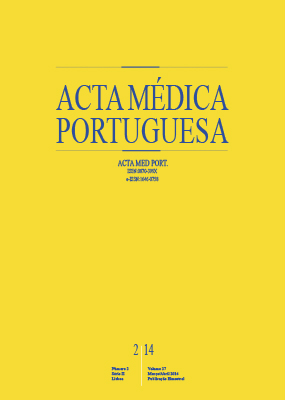Relation between Metformin Treatment and the Development of Hyperlactacidemia at the Emergency Room
DOI:
https://doi.org/10.20344/amp.4071Abstract
Introduction: In type 2 diabetic patients treated with metformin the development of hyperlactacidemia or even lactic acidosis seems to result from an acute precipitating event. This study aims to assess the prevalence and relative risk of hyperlactacidemia in diabetic patients admitted in the Emergency Room, the predictive factors for high lactate concentration and the influence of hyperlactacidemia in patients’ prognosis.Material and Methods: Transversal observational study including patients observed between June and October 2012: 138 type 2 diabetics, 66 treated with metformin, and 83 non-diabetic patients. Studies’ variables: age, sex, cause of admition, blood pressure, drugs, personal history, analytical study (biochemistry and arterial blood gas analyses with lactate) and destination. Statistical analysis was performed using SPSS 21.0®.
Results: Mean lactate concentration and hyperlactacidemia prevalence were significantly higher in diabetic patients (2.1 ± 0.1mmol/L vs 1.1 ± 0.1mmol/L, p < 0.001 and 39.1% vs 3.6%, p < 0.001, respectively) and in those under metformin compared to other diabetics (2.7 ± 0.2 mmol/L vs 1.6 ± 0.1 mmol/L, p < 0.001 and 56.9% vs 23.3%, p < 0.001, respectively). Diabetics on metformin presented a 25-fold increased risk of hyperlactacidemia (OR = 25.10, p < 0.05). Creatinine was the only independent predictive factor for lactate
concentrations (B = 1.33, p < 0.05). Patients with hyperlactacidemia had 4.4 times higher odds of being hospitalized or dying (OR = 4.37, p < 0.05). When hospitalized, they had longer hospitalization periods (21.66 ± 5.86 days vs 13.68 ± 5.33 days, p < 0.001) and higher rate of deaths (12.5% (n = 4) vs 4.3% (n = 2), p < 0.05).
Conclusion: There was an increased risk of hyperlactacidemia in patients with type 2 diabetes, particularly for those under metformin. Serum creatinine represented the only independent associated factor of lactate concentration. The presence of hyperlactacidemia was associated with worse prognosis.
Downloads
Downloads
Published
How to Cite
Issue
Section
License
All the articles published in the AMP are open access and comply with the requirements of funding agencies or academic institutions. The AMP is governed by the terms of the Creative Commons ‘Attribution – Non-Commercial Use - (CC-BY-NC)’ license, regarding the use by third parties.
It is the author’s responsibility to obtain approval for the reproduction of figures, tables, etc. from other publications.
Upon acceptance of an article for publication, the authors will be asked to complete the ICMJE “Copyright Liability and Copyright Sharing Statement “(http://www.actamedicaportuguesa.com/info/AMP-NormasPublicacao.pdf) and the “Declaration of Potential Conflicts of Interest” (http:// www.icmje.org/conflicts-of-interest). An e-mail will be sent to the corresponding author to acknowledge receipt of the manuscript.
After publication, the authors are authorised to make their articles available in repositories of their institutions of origin, as long as they always mention where they were published and according to the Creative Commons license.









